What does it really mean to build a client-centric agency? And how do you go about building one? Find the right answer in this post.
The agency business is a service business. And being a service business, you would assume that the people they service - clients - would be at the center of their operations.
In reality, while most agencies claim to be ‘client-centric’, few walk the talk. Despite their best efforts, other concerns - bringing in new clients, hiring talent, and growing the agency - take primacy over clients.
The end result is all too familiar: high client churn, anemic growth, and growing employee turnover.
If your agency is to grow in the next decade, being client-centric shouldn’t just be an idea you pay lip service to; it should be your core value.
Accomplishing this, however, isn’t easy. Client-centricity isn’t something you can build overnight to hack together with a handful of tools. Rather, it has to be embedded in your agency’s culture and principles.
I’ll show you how to build this client-centric agency culture below.
Why Being Client-Centric Matters
While being client-centric sounds nice on paper, how does it truly benefit your agency? Aren’t your resources better spent growing your client roster and nurturing talent instead?
That’s how most agencies rationalize their slow departure away from client-centric principles. Growth - in revenues and number of clients - is easy to measure. Client-centricity is not.
However, even though it’s not readily trackable, being customer-centric offers some incredible, long-term benefits:
1. Leads to longer relationships
How long do your client relationships last on average?
If you’re like most agencies, it would be between 3-5 years. One study found the average length of agency-client relationships to be 3.2 years.
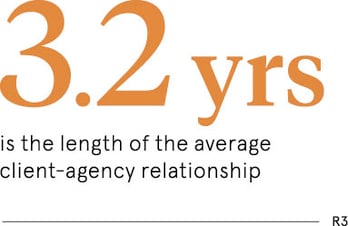
This might sound good enough, but if you look at large agencies, you’ll find that the average length of their client engagements is much, much higher. For a top 40 agency, a client relationship lasts 22 years on average.
In fact, the data shows that the average agency-client relationship has more than halved since the late 1990s.
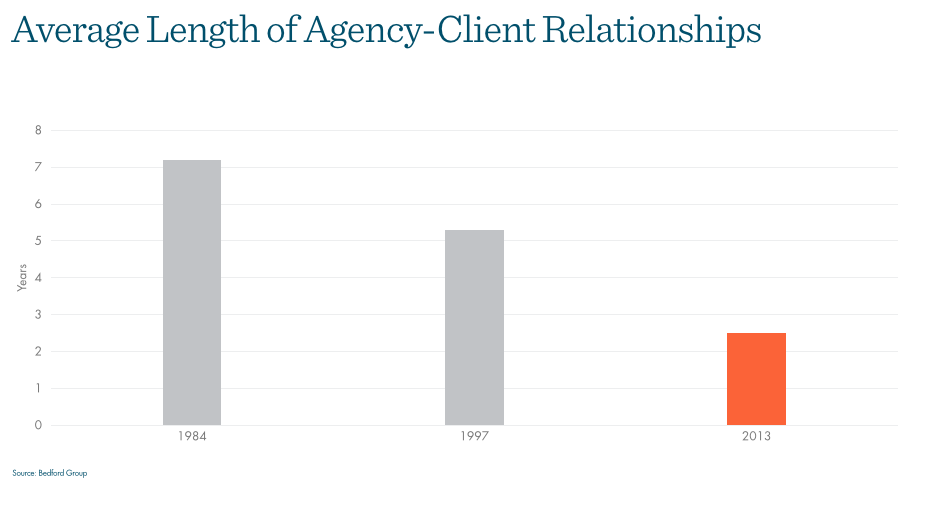
While there’s a huge list of reasons for this change, it is generally difficult to retain a client for more than 5 years on performance alone. That’s the time period beyond which original stakeholders change and companies change their strategic direction.
If you’re not a customer-centric agency, you’ll find that you’re never able to build the trust channels that lead to decade long relationships.
Client-centricity frees you from the spreadsheets of performance and turns you into a trusted partner, not just someone who sends flattering reports.
2. It improves morale and helps retain employees
It’s no secret that attrition rates in the agency business are among the highest of all industries. Most agencies even say “competition for talent” is one of their biggest challenges.
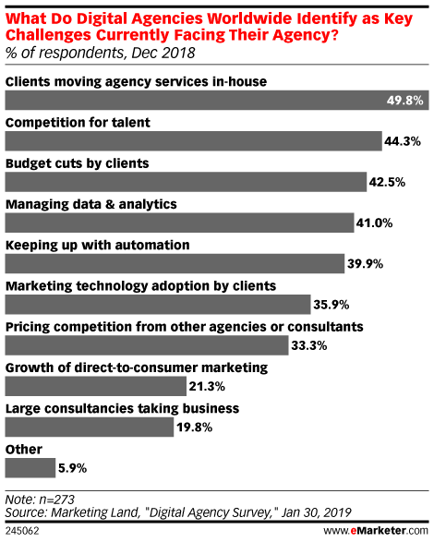
Agencies can often feel like mercenary environments. They land a client, run through a process, show some results and move on to the next lead. There is little room for building the kind of relationships that lead to a real sense of reward and accomplishment.
Little wonder that agency employees cite a lack of “satisfying work” as one of the top reasons for leaving their last job.
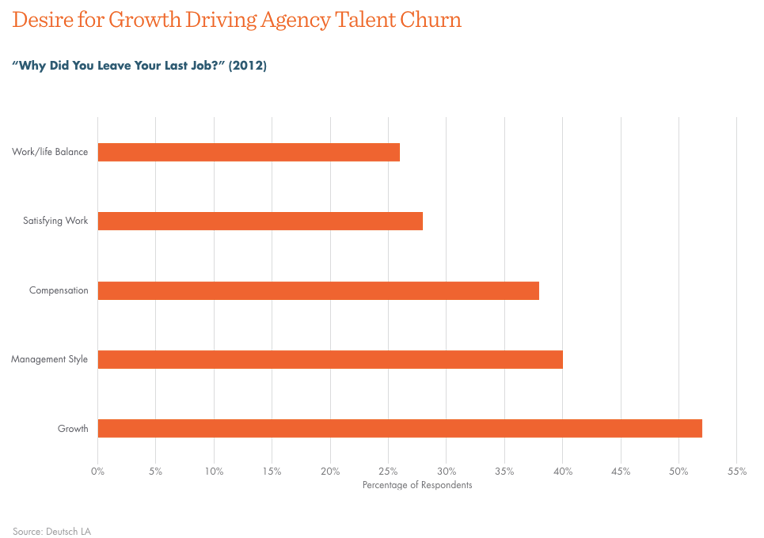
One way to offer a more satisfying work environment is to give your employees something to value beyond money - a sense of mission. Mission-driven companies routinely say they have higher employee engagement and happier customers.
By focusing on the mission of growing your clients’ businesses, you’ll find that your employees have a stronger sense of loyalty and satisfaction with their work.
How to Build a Client-Centric Culture
Client-centricity can’t really be tacked onto your agency. It’s not a process or a tool you can readily integrate into your operations.
Rather, it’s a way of thinking and a set of values. Client-centric agencies are organized around clients, not product, marketing, or operations. The client’s needs and growth trump all other considerations.
How exactly do you go about building this culture? And what does it mean to be ‘client-centric’?
I’ll share some answers below.
Understanding Client Centric Cultures
Your business’ culture is a measure of the values you promote and the values you actively suppress.
In a client-centric business, anything that promotes the client’s happiness and growth would take top priority. Anything that doesn’t would be suppressed.
Your decision making swings on the question: Will it help our clients?
This sounds great on paper, of course, but seldom works out in reality. You might start your agency with the intention of prioritizing clients, but the needs of the business - growing revenues, and attracting talent - eventually take precedence.
Overdeliver for a loyal client going through a rough patch and you’ll be “client-centric”. But you’ll also see your profits dip in the short-term.
Being client-centric, thus, means adopting two of the toughest values in business:
- Giving, where the business is willing to give more than it takes in the near term for stronger relationships in the long run
- Long-term thinking, where the business prioritizes long term results over short term goals
You’ll often find examples of this approach among tech businesses. Jeff Bezos famously outlined this sort of long-term, customer-focused approach in Amazon’s first pre-IPO letter to shareholders.
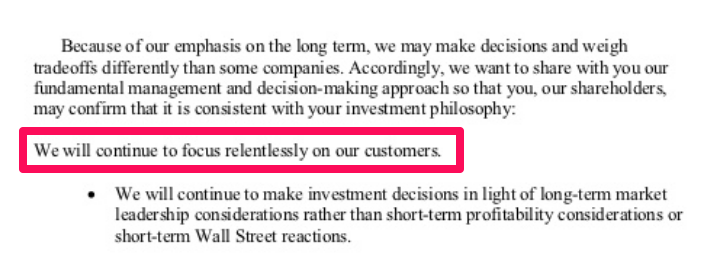
So when you think of building a customer-centric culture, think of long-term results, not short-term goals. Take decisions that prioritize client success first, and everything else (including the growth of your agency) second.
This requires strong leadership, but the rewards are long-term growth and relationships that last decades, not years.
On that note, let’s look at some concrete steps you can take to build a client-centric culture.
5 Steps for Building a Client Centric Agency Culture
The first thing you should know is that creating a client-centric culture is neither fast nor easy. More often than not, you’ll have to rework your agency’s structure and values. From an Accounts or Creative-led agency, you’ll have to get leadership to buy into a client-led vision of growth.
Provided you can get this leadership buy-in, what steps can you take to adopt client-centricity?
I’ll share some tips below.
1. Audit your existing client-centricity
As with most changes, your first step should be to figure out where you currently stand. How client-centric is your culture currently? What can you improve? What are you doing well enough?
Some questions you should consider:
- What is your average client churn rate?
- Why did your last five clients leave you?
- How long are your three most valuable client relationships? What do you differently for them than other clients?
- Is being client-centric a core part of your vision, onboarding, and mission statement?
- Is being client-centric reinforced in employee hiring and training? Do you actively select for client-centric traits?
- What values dominate decision making at the executive level? In other words, what is your agency’s North Star - sales, creative, or clients?
- Do you have any objective measure of client happiness, such as NPS scores?
- How is client-centricity reflected in your project plans?
- How do you engage clients from the moment you land a deal to the moment you hand over the final deliverable?
2. Understand your clients
Digging through your data is only one part of the audit process. The other part is actually understanding your clients.
How you choose to go about it will depend on your agency and the kind of relationships it has with its clients. But a good process is to select at least five clients that represent:
- Your most profitable client
- Your most satisfied client (by NPS score)
- Your least satisfied client (by NPS score)
- A client who recently left your agency
- A client that has been with you the longest
You can go beyond this but covering these five types of clients will give you a good picture of your agency.
Now interview these clients. Try to understand why they’re happy (or unhappy) with your agency. Outside of your work and results, what draws them to (or away) from your agency? Are there any standout performers in their interactions with your people? If yes, what traits do these performers represent?
Analyze this data for patterns. Is there anything common across all your interactions with these clients? Do you follow the same processes across all clients? If not, what do you do differently for your best and worst performing clients?
Your goal should be to map out deficiencies in your processes, plug any gaps, and identify the character traits that align with client happiness (from a client’s perspective).
3. Organize your processes
One of the reasons why client-centricity is hard to achieve is that it is simultaneously consistent and specialized. A client in a client-centric organization receives service that is consistent across departments and projects, regardless of the client’s size or sector.
At the same time, when necessary, client-centric agencies don’t hesitate to jump in and change things around to give specialized service.
While offering this specialized service is easy enough (mostly because it represents one-off cases), it’s much harder to streamline your processes for consistency. If client experience is fragmented, you’ll end up working way too hard creating ad-hoc solutions that leave some clients happy, but others bitterly unsatisfied.
As we wrote earlier, the solution to this problem is to organize your agency for scalable growth. This means:
- Document your processes and assess their existing maturity
- Map the client flow as they move from prospect to lead to client to final delivery
- Analyze and remove shortcomings, inefficiencies, and bottlenecks (refer to your audit above)
The next step is to create consistent experiences for different clients based on the context of their needs. A $500,000 client with a multi-year engagement needs a different delivery process than a $5,000 client with a 3-month, one-off project.
For instance, you might have separate processes for clients coming from different sources. This will ensure that clients you come in through, say, inbound channels get the experience promised by your inbound processes. And clients who come in through referrals get an experience that’s consistent with their referrers.
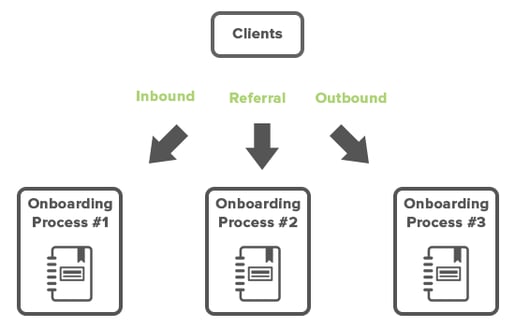
4. Rework your agency’s focus and values
So far, the steps we’ve considered are process-focused.
While these can help you streamline operations and promote client-centricity, they’re, at best, a short-term panacea.
To build a truly client-centric agency, you have to make clients the heart of your agency’s principles and policies.
Consider an example: a client comes to you for a marketing project. After delivering the project, you find that the client’s poorly designed website doesn’t let them realize the full benefits of your project.
Upgrading this website, however, is out of the picture since they don’t have the budget for it.
At this point, a regular agency would wash its hands off the client and look for a new one.
But a client-centric agency might deliver a better-designed website for free, sans expectation. Not only does this help the client (and earn their business for years), it also helps the agency deliver the best possible results.
Adopting this client-centric approach means changing every aspect of your agency’s existence. Serving clients shouldn’t be what you do in addition to your creative work; it should be your work.
This means:
- Making client happiness a core part of your mission statement, beliefs, and values
- Adopting client-friendly policies when it comes to revisions, change requests, etc.
- Seeing clients as partners, not adversaries to be profited from, at all levels of your agency’s operations
- Giving managers a free hand to change policies if it benefits the client
- Measuring your success in terms of your client's success, not just revenue and growth metrics
In other words, the only way to be client-centric is to actually be client-centric. Ask “How does it help our clients?” before making any big decision and you’ll earn long-term loyalty from your clients.
One way to build a client-centric agency is to improve your efficiency. Every lost email and misplaced request detract from your goal of client friendliness.
Try using software like Workamajig to bring more clarity and efficiency to your projects. Try out a free demo below to see how Workamajig can transform your agency’s operations.

